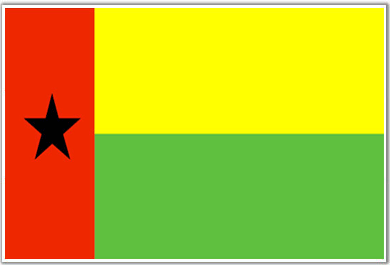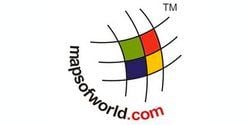- Neighboring Countries - Guinea, The Gambia, Senegal
- Continent And Regions - Africa Map
- Other Guinea Bissau Maps - Guinea Bissau Map, Where is Guinea Bissau, Guinea Bissau Blank Map, Guinea Bissau Road Map, Guinea Bissau River Map, Guinea Bissau Cities Map, Guinea Bissau Political Map
Influenced by the flag of Ghana, the flag of Guinea-Bissau features the traditional Pan-African colors of green, gold, and red.
The flag comprises two horizontal stripes of gold (top), and green (bottom), and one red vertical stripe on the left side of the flag. The red band consists of a black five-pointed star that represents the unity of the African nations.
All the colors used in the flag have their own significance. Red stands for the blood shed by the country’s ancestors in their prolonged struggle for independence from Portugal; gold symbolizes the abundance of minerals found in the country; it can also be interpreted as the bright sunshine that Guniea-Bissau experiences. Green represents the lush green forests found in the country, and agriculture and is also a symbol of unending hope to do better.
The flag of Guinea-Bissau was officially adopted on September 24, 1973, the day the Portugal regime ended and the country won independence.
| Official Name: | Republic of Guinea-Bissau |
| Flag Proportion: | 1:2 |
| Adopted on: | September 24, 1973 |
| Location of Guinea Bissau: | West Africa; Bordered by Senegal, Guinea, and the Atlantic Ocean |
| Capital City of Guinea Bissau: | Bissau |
| Major Cities of Guinea Bissau: | Bolama, Bissora, Fulacunda |
| Area of Guinea Bissau: | 36125 sq km / 13,948 square miles |
| The population of Guinea Bissau: | 19.7 lakhs (2020) |
| Currency: | West African Franc (XOF) |
| Official Language of Guinea Bissau: | Portuguese |
| National Anthem: | This is Our Well-Beloved Motherland |
| National symbol(s): | black star |
| National colors: | red, yellow, green, black |
| National anthem: | |
| Name: | “Esta e a Nossa Patria Bem Amada” (This Is Our Beloved Country) |
| Lyrics/Music: | Amilcar Lopes CABRAL/XIAO He |
Fact about the Guinea-Bissau flag |
| Country | Guinea-Bissau |
|---|---|
| Designed by | NA |
| Adopted | 1973 |
| Revision | NA |
| Design and Colors | One vertical red line on the hoist side charged with a black five-pointed star; two horizontal lines on the fly side (yellow and green) |
| Size Ratio | 1:2 |

 Interesting Facts about Guinea Bissau
Interesting Facts about Guinea Bissau